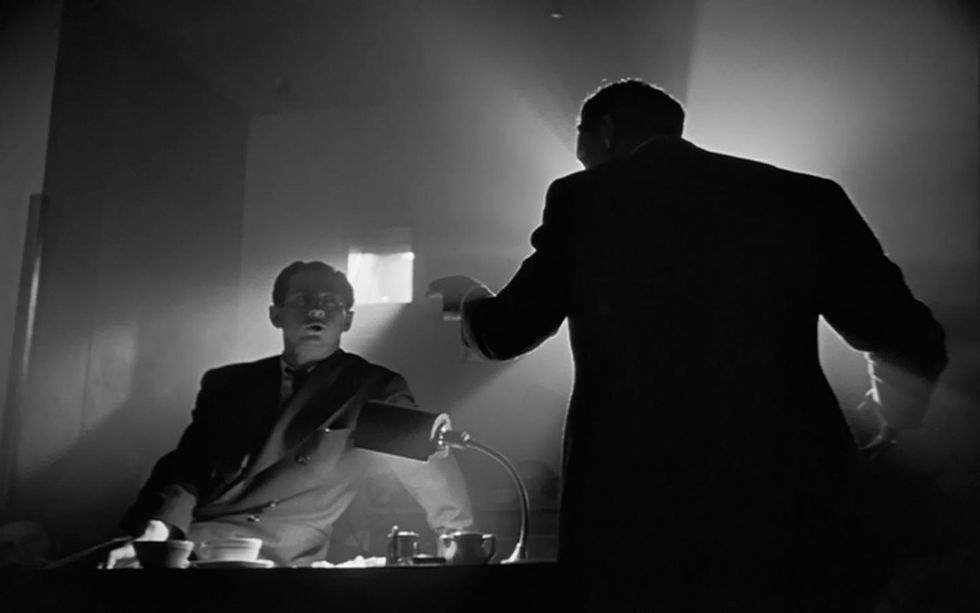What Is Hard Lighting in Film and TV?
And how can you use it in your productions?

'Double Indemnity'
There are so many different kinds of lighting it can be hard to keep track. But that's why we're here to help you sort through it.
One distinctive lighting technique that has captivated audiences and filmmakers alike is "hard lighting." It's one of those things you'll recognize as soon as you see it.
In this article, we delve into the concept of hard lighting, its characteristics, applications, and how it contributes to cinematic narratives.
Let's get started.
Cinematic Lighting 101 | How to Use Hard Lightwww.youtube.com
Hard Light Definition

'Citizen Kane'
Credit: Warner Bros.
Hard lighting refers to a lighting setup that creates strong, well-defined shadows and high contrast between illuminated and shaded areas.
Unlike soft lighting, which produces gradual transitions between light and shadow, hard lighting creates sharp, distinct boundaries between the two.
This technique can be achieved by using a focused, intense light source that casts minimal diffused light onto the subject or scene.
The Characteristics of Hard Lighting
- Sharp Shadows: One of the defining features of hard lighting is the presence of sharp, well-defined shadows. These shadows can contribute to the visual composition by adding depth, texture, and dimension to the image.
- High Contrast: Hard lighting results in a stark contrast between bright and dark areas. This heightened contrast can create a sense of drama and intensity, effectively drawing the viewer's attention to specific elements within the frame.
- Texture Emphasis: The strong shadows produced by hard lighting can emphasize textures and details, making them more pronounced and noticeable. This is particularly effective in highlighting the textures of objects, surfaces, and characters' features.
- Minimal Diffusion: Unlike soft lighting, which employs diffusers and bounce surfaces to scatter light, hard lighting minimizes diffusion. This leads to a direct, focused beam of light that produces the characteristic sharp shadows.
Why Use Hard Lighting in Film and TV
 'Scream VI'
'Scream VI'Credit: Paramount Pictures
- Film Noir Aesthetics: Hard lighting has historically been associated with film noir, a genre known for its dark and moody visual style. The interplay of shadows and light in hard-lit scenes can intensify the film's themes of mystery, tension, and moral ambiguity.
- Dramatic Scenes: When used effectively, hard lighting can amplify the emotional impact of dramatic scenes. It can accentuate facial expressions, add gravitas to confrontations, and underscore the emotional turmoil of characters.
- Horror and Thrillers: The unsettling nature of hard lighting makes it an ideal choice for horror and thriller genres. By casting eerie shadows and creating an atmosphere of suspense, hard lighting can evoke fear and unease in the audience.
- Period Pieces: Hard lighting can be employed to recreate historical or period-specific visuals. It can emulate the lighting techniques of older films or reflect the limited technology of the era, enhancing the authenticity of the setting.
- Stylized Visuals: In more experimental or avant-garde works, hard lighting can be utilized to create bold, visually striking compositions that challenge the norms of traditional cinematography.
How to Use Hard Lighting in Film and TV

'Zodiac'
Credit: Paramount Pictures
Look, none of this is fun to learn about if you're not going to use it. So if you want to use it, here's a few things to keep in mind.
- Light Placement: Position the light source at a steep angle to the subject to create strong shadows. Experiment with different angles to achieve the desired level of contrast and shadow intensity.
- Light Intensity: Use high-intensity lights to achieve the harshness of hard lighting. However, be cautious not to overexpose highlights or lose important details.
- Control Shadows: Employ flags, barn doors, or other blocking tools to control the direction and shape of shadows. This allows for precise sculpting of the scene's lighting.
- Fill Light: Introduce a subtle fill light to slightly soften the shadows and mitigate extreme contrast, striking a balance between dramatic effect and visual clarity.
Hard lighting is a powerful cinematic tool that can elevate storytelling by adding depth, contrast, and emotion to visual narratives.
By understanding its characteristics and applications, filmmakers and cinematographers can harness the creative potential of hard lighting to craft captivating and unforgettable scenes.
Now go get lighting.
- 13 Film Lighting Techniques Every Filmmaker Should Know ›
- Watch: Learn the Fundamentals of Light Quality in Less Than 8 Minutes ›
- 4 Pro Tips for Working with Hard Light ›











